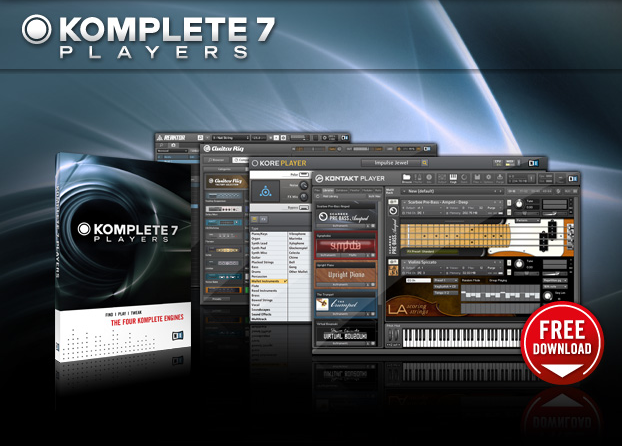
- #KONTAKT 5 PLAYER DOWNLOAD HOW TO#
- #KONTAKT 5 PLAYER DOWNLOAD FULL VERSION#
- #KONTAKT 5 PLAYER DOWNLOAD PLUS#
- #KONTAKT 5 PLAYER DOWNLOAD DOWNLOAD#
Then press OK and presto, your scale is saved as a. scl file, first type a description in the Description line at the bottom (some synths refuse to play a Scala file unless there is something in this line), make sure your directory is selected correctly in the “Save in folder” line, and type a file name, ending in. Go to File/Save Scale As and you’ll get a page like this:

#KONTAKT 5 PLAYER DOWNLOAD HOW TO#
(Note: Jacky Ligon wrote an article about how to set your centre key and root tuning in Scala – we won’t cover that here, but it’s pretty important material, so to refer to that here. Even though Kontakt doesn’t, let’s show how we do that. Most synthesizers understand the Scala.scl format. Having gotten our tuning, and pressed F6 to get a listing of the current tuning, and having it listed like this, we now need to save the file in a form that our target synthesizer/sampler can understand. The important listings here are the second column, which is the ratios of the tuning, and the third column, which is the listing of the pitches of the tuning in cents, or 1/100ths of a semitone. Then press OK and in the Scala main window, press F6 to get the scale listing printed out. In Options, uncheck “Delete 1/1 from result scale.” This is shown in the first screenshot below. In Kind, check the option called Corner (utonal superstellated). In the window that appears, type in the following values: In Factors – type in 3 17 51. Even though we can’t go into any depth in how to generate scales in Scala, let’s quickly show how our example scale was made. Here’s a 7-note scale made with Scala (second of the two images below). Opening Scala, we can use some of its many tools to make a scale. And while a complete tutorial on Scala is not possible here, we can at least cover how to use it to produce a scale file which can be used in Kontakt. Using the program Scala, one can make scale files, and then save them as Kontakt ready text files. txt Filesįortunately, there’s a better way.
#KONTAKT 5 PLAYER DOWNLOAD DOWNLOAD#
If you had access to a complete Kontakt Tuning Script, say for twelve-tone equal temperament (and one is available for download here, if you wanted to, you could painstakingly assemble by hand a complete Kontakt Tuning Script which could be copied and pasted into Kontakt (more on this later, too). So these three pitches are middle C (MIDI 60) and then two detuned Ds above that, one 3.910c sharp and the other 9.911 cents sharp. The next two lines say that when MIDI key 62 is received, MIDI key 62 is played, but with a detuning of +9.911 cents. Note 2: In the number 3910, the last 3 digits are assumed to be after a decimal point.) Numbers in this slot (%tune) can be from +50000 to -50000, so a tuning of +/- a half a semitone is possible. (Note 1: This is not a mistake – incoming Note 61 is indeed now routed to Note 62 to get the proper sampled key for the desired tuning. Line 3 says that when MIDI key 61 is received, MIDI key 62 is to be played in the Kontakt program, with a detuning of +3.910 cents. So the first two lines say that when middle C (MIDI 60) is received, MIDI 60 (middle C) will be played, with no detuning. The second line says that there will be 0 pitch detuning. This first line tells Kontakt that when MIDI note 60 is received, MIDI note 60 should be played in the Kontakt program. Here’s an excerpt from a Kontakt Tuning Script.
#KONTAKT 5 PLAYER DOWNLOAD PLUS#
This is a text file that tells Kontakt to play certain notes with certain amounts of detuning – generally no more than plus or minus 50 cents. Hopefully, this article will serve that purpose.įirst of all, microtuning in Kontakt is accomplished through the use of a Tuning Script. What has been needed, a group of my friends and I feel, is a very clear (idiot’s) guide to how do microtuning in Kontakt. Once you “get there,” it’s a very powerful and easy way to do microtuning, but alas, the documentation for how to do it is scattered around a number of sources. One of its powerful features is its ability to do microtuning – in a way that, depending on the programming of the sample set – usually doesn’t distort the timbre of the samples.
#KONTAKT 5 PLAYER DOWNLOAD FULL VERSION#
Kontakt 5, and now Kontakt 6 – the full version – is a very feature-rich sampler. Hopefully this article will change that state of affairs.

Microtuning in Kontakt is possible but how to do it is not well-documented.


 0 kommentar(er)
0 kommentar(er)
